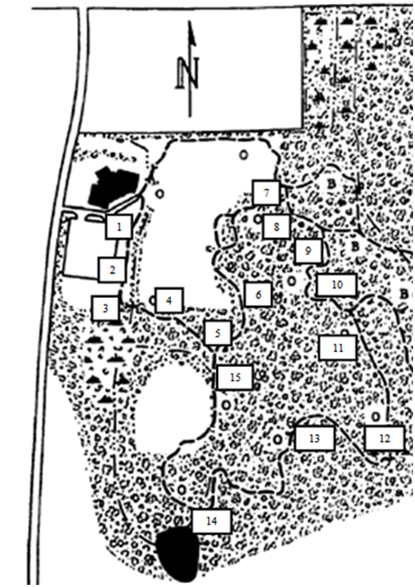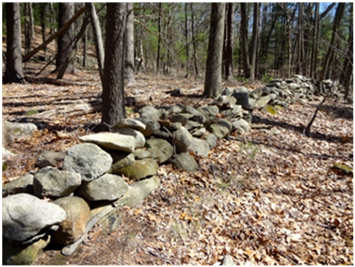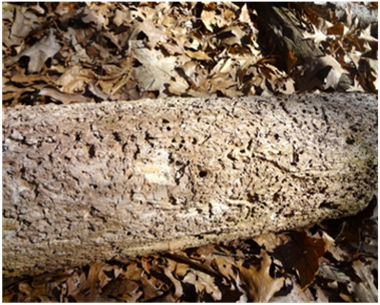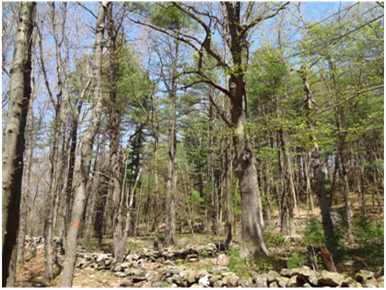Station Locations Map
-
-
Station 1: Forest Meets the Field
As you enter the trail, you begin to walk along an ecotone – a zone where two habitats meet. At this spot, the forest meets the field. The boundary is marked by the presence of both trees, such as Big-Toothed Aspen and Red Oak, and plants like Common Mullein, Goldenrod, and Smooth Sumac. Many animals find food in this area: squirrels and deer eat acorns from the oak, while birds eat the berries on the sumac.
-
Station 2: Stream
At this stop you can see the stream. Common Yellowthroats bathe in it in the springtime. Despite its bright yellow throat and chest, this songbird is easier to hear than see; listen for its characteristic “wich-i-ty, wich-i-ty, wich-i-ty”. Other birds can also be heard around the stream in the spring. Listen for the “birdie, birdie, birdie” whistle of the Northern Cardinal and for the Black-capped Chickadee saying its name: “chickadee-dee-dee”.
-
-
Station 3: Swamp
Look to your right and you will see a swamp. Water has gathered in a depression formed by the last glacier and created this forested wetland. The swamp is home to many organisms ranging from aquatic insects to birds. As you stand by the swamp in the springtime, you can hear the mating calls of various frogs and toads. The Wood Frogs have a quacking call, the Spring Peepers a piercing call, and the American Toads a trilling call. Can you hear any of the three?
-
-
Station 4: Open Field
On the other side of the gate you will see an open field filled with Goldenrod, Joe-Pye weed, and Aspen. The field is mowed once every two years to prevent ecological succession, or change in the species structure. If the field underwent succession and became a forest, sparrows, mice, woodchucks, woodcocks, and other meadow-dwellers would lose their habitat.
-
-
Station 5: Stone Wall
A farmer built this stone wall as he cleared his fields and pastures for tilling. Walls made with large boulders encircled cattle and other livestock, while walls made with smaller rocks outlined the fields. These rocks and boulders are till, sediments deposited directly by the last glacier when it receded about 10,000 years ago.
-
Station 6: Succession
Although succession is controlled in the field, it has been left unchecked here since the closing of the farm. This area used to be a pasture, but when the grazing by livestock stopped, it became overgrown. White Pines began to grow and then deciduous trees (trees that lose their leaves) sprouted up in their shade. The many dead trees, or snags, among the pines are important habitats for birds and insects.
-
Station 7: The Chestnut Tree
Here you will find a Chinese Chestnut tree, distinct from the American Chestnut in that its leaves are oval-shaped, thick, and waxy (rather than long, thin, and papery) and its stem is hairy (rather than smooth and hairless). Around 1900, a fungus was carried over from Asia that caused the American Chestnut blight. The Chinese Chestnut has some immunity to this disease, and today scientists are working on a new hybridization between the American and Chinese Chestnut trees. The seed of the Chestnut is an important source of food for wildlife such as deer, squirrels, and turkeys, but to eat it they must first get through the prickly husk.
-
Station 8: Pitch Pine
On your way up towards the Pine Grove from the junction of the orange and blue trails, you come upon a pitch pine. The Pitch Pine is unique in how it reacts to fire. It has thick, fireproof bark and if its needles burn, it can regenerate branches and foliage. Its twigs and pine needles do not decompose very quickly and can serve as tinder. The occasional wildfire benefits the tree by wiping out non fire-resilient competing species and by causing the cones to
Station 9: Huckleberry vs. Blueberry
While it is commonly thought that a shrub with bluish berries is a Blueberry bush and a shrub with more purplish berries is a Huckleberry bush, this is not always the case. In front of you are both a Huckleberry bush and a Blueberry bush; can you tell which is which? The Huckleberry bush has the brown stem and the Blueberry bush has the green stem. Despite their differences, both the Huckleberry bush and the Blueberry bush provide food for wildlife such as turkeys, deer, and grey foxes.
-
Station 10: Pine Grove
Welcome to the Pine Grove. If you look up in the trees, you can see a nesting box. That box was made for a Screech Owl, but is usually inhabited by a Red Squirrel instead. Is he or she home?
-
-
Station 11: Decomposition
As you walk away from the Pine Grove, you may notice a lot of brush piles, blow-downs, and fallen logs. Audubon does not clear these so that they can decompose naturally and recycle their nutrients back into the soil. Fallen logs support life and provide new homes for many organisms. Isopods, carpenter ants, termites, centipedes, millipedes, and mushrooms, such as turkey tail, are all commonly found in and around these fallen logs. Along this part of the trail you may also spot middens or little piles of pinecone scales. Red Squirrels make these as they consume the seeds in the pinecones they stored for the winter.
-
Station 12: Bridge
You are now standing in a wetland. Wetlands are areas of land that are either saturated or covered with water such as swamps, bogs, and marshes. Wetlands provide important ecological services and are therefore valuable to both wildlife and humans. They filter debris, toxins, and excess nutrients out of the water; mix nutrients and oxygen into the water; neutralize toxic substances; prevent flooding by absorbing water; and provide great habitats. Wetlands serve as nurseries for the young of many insects, crustaceans, amphibians, and reptiles, as they provide both shelter and food. Wetlands are also great nesting, resting, and wintering places for migratory birds. Various plants, such as White Violets, Sphagnum Moss, and Skunk Cabbage, also populate the wetland.
-
Station 13: Bark Beetle
Look down at the logs lining the trail. See those markings that seem to be carved into the wood? That is not an ancient inscription, but the work of a bark beetle. Bark beetles attack weakened trees and recently cut wood that still has its bark, and tunnel their way through creating these galleries.
-
-
Station 14: Pond
Welcome to the pond, home to a variety of organisms from ducks to crayfish. In the summer you can see Painted Turtles, also known as Sun Turtles, basking on logs, and hear the calls of frogs. Green Frogs make a sound like the plucking of a banjo, while the Bullfrog makes a “drum, drum” sound. Later in the summer you may also see the Meadowhawk dragonflies doing their dance of love while in flight.
-
-
Station 15: Wolf Tree
Here behind the stone wall is a wolf tree. Wolf trees were typically left by farmers at the border of a property or pasture to provide shade for the grazing cattle. They are frequently found along rock walls and have wide-spread crowns. Also in the stone wall is a big quartz rock. Quartz is one of the most common minerals on earth and can come in many varieties. Colorless quartz, like this specimen, is often referred to as rock crystal.
-




























